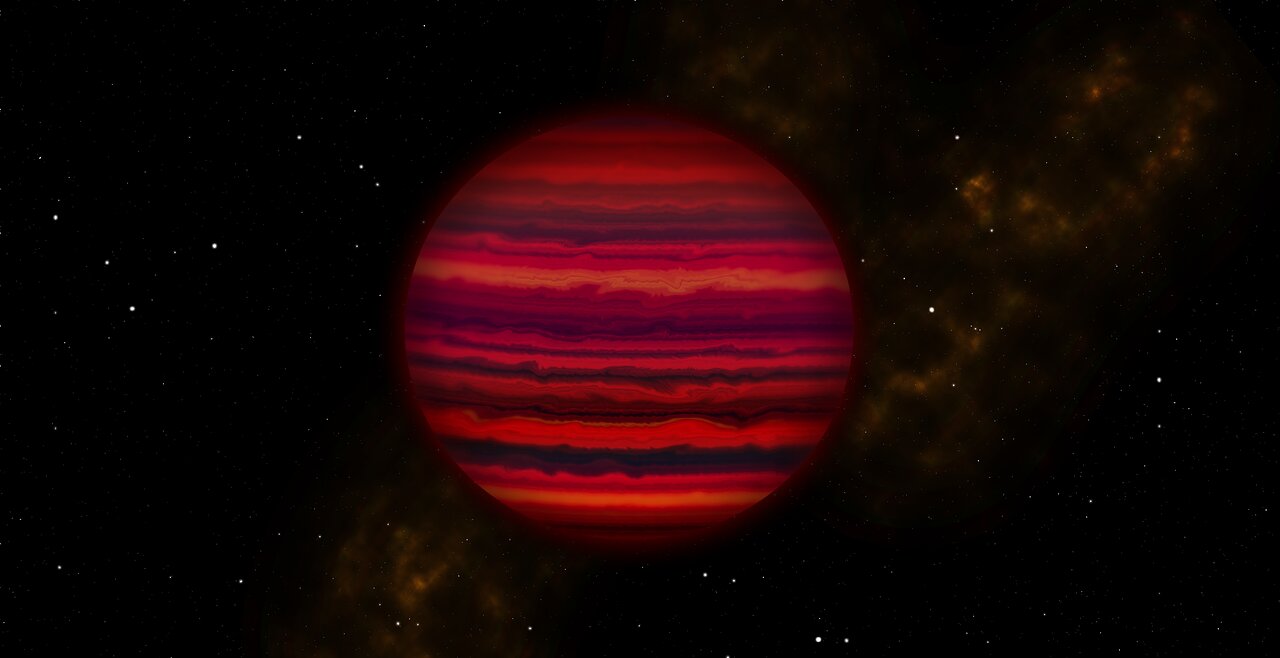Exploring a Frozen Extrasolar World
July 5, 2016

As the Juno mission begins exploring Jupiter in our Solar System, scientists explore a solo world that researchers say looks more similar to Jupiter than any exoplanet yet discovered.
Astronomers have “cracked” a very cold case with the dissection of light from the coldest known brown dwarf. In fact, the brown dwarf, named WISE 0855, is billed as the most frigid discrete world yet discovered beyond our Solar System. The research also presents the strongest evidence yet for water clouds in the atmosphere of an extrasolar object.
The history of “failed stars” having masses between that of a star and planet – called brown dwarfs – continues to blur. Now, that distinction is even more ambiguous with the confirmation that WISE 0855 shares more of a likeness with Jupiter than many exoplanets.
New evidence for this comes from the first spectroscopy, or light fingerprint, of the object, performed at the Gemini North telescope in Hawai’i. The spectrum presents astronomers with the most definitive evidence ever for water vapor in the atmosphere of an object outside of our solar system. The research also confirms that temperatures dip to about 20 below zero Celsius (-10 degrees F) in its cold atmosphere.
WISE 0855 was discovered by Kevin Luhman of Penn State in 2014 using data from NASA’s Wide-field Infrared Survey Explorer (WISE) satellite. WISE 0855’s relatively close proximity – it’s only about 7.2 light years away, the fourth closest extrasolar object to the Sun – provides an advantage in capturing the object’s miniscule glow; however, it is still remarkably difficult to observe.
"It's five times fainter than any other object detected with ground-based spectroscopy at this wavelength," said Andy Skemer of the University of California Santa Cruz. "Now that we have a spectrum, we can really start thinking about what's going on in this object. Our spectrum shows that WISE 0855 is dominated by water vapor and clouds, with an overall appearance that is strikingly similar to Jupiter." Skemer is first author of a paper on the new findings to be published in Astrophysical Journal Letters and currently available online.
“I think everyone on the research team really believed that we were dreaming to think we could obtain a spectrum of this brown dwarf because its thermal glow is so feeble,” said Skemer. WISE 0855, is so cool and faint that many astronomers thought it would be years before we could dissect its diminutive light into a spectrum. “I thought we’d have to wait until the James Webb Space Telescope was operating to do this,” adds Skemer.
The spectrum, obtained using the Gemini North telescope on Hawaii’s Maunakea, was obtained over a period of 13 nights (about 14 hours of data collection). “These observations could only be done on a facility like Gemini North. This is due to its location on Maunakea, where there is often remarkably little water vapor in the air to interfere with the sensitive observations, and the technology on the telescope, like its 8-meter silver-coated mirror,” says Jacqueline Faherty of the Carnegie Department of Terrestrial Magnetism. “We pushed the boundary of what could be done with a telescope here on Earth. And the result is spectacular."
The resulting high-quality spectrum reveals water vapor and clouds in the object’s atmosphere, and opens opportunities to explore the atmosphere’s dynamics and chemistry. Gemini astronomer, and brown dwarf researcher, Sandy Leggett explains that the spectrum shows less phosphine than we see in Jupiter, “...suggesting that the atmosphere may be less turbulent, since mixing produces the phosphine seen in Jupiter's atmosphere.”
Results from previous observations of WISE 0855, published in 2014, provided hints of water clouds based on very limited photometric data (the relative brightness of specific wavelengths of light). Skemer, also a coauthor of the 2014 paper, adds that with spectroscopy scientists are able to separate the object’s light into a wide range of infrared wavelengths, and probe the body’s molecular composition. “If our eyes could see infrared light, which is redder than the reddest light we can see, the data would look like a rainbow of colors.” He adds, “The relative brightness of each color gives us a glimpse into the environment of the object’s atmosphere.”
The coauthors of the study include graduate student Caroline Morley and professor of astronomy and astrophysics Jonathan Fortney at UC Santa Cruz; Katelyn Allers at Bucknell University; Thomas Geballe at Gemini Observatory; Mark Marley and Roxana Lupu at NASA Ames Research Center; Jacqueline Faherty at the Carnegie Institution of Washington; and Gordon Bjoraker at NASA Goddard Space Flight Center.
Observations for this work were made using the Gemini Near-InfraRed Spectrograph (GNIRS) which is mounted on the Gemini North telescope on Maunakea in Hawai‘i. The research team, and Gemini staff, are grateful to be able to observe from Maunakea, Hawaii’s highest peak, where conditions are ideal for these types of observations.
Links
- University of California, Santa Cruz press release.
- A video about the discovery and study of WISE 0855 (rendered using the American Museum of Natural History's Digital Universe).
Contacts
Peter Michaud
pmichaud@gemini.edu
808-936-6643
Public Information and Outreach Gemini Observatory
Hilo
Hawai‘i
Tim Stephens
stephens@ucsc.edu
(831) 459-4352
University of California, Santa Cruz
Andrew Skemer
askemer@ucsc.edu
(831) 459-5753
University of California
Santa Cruz
Jacqueline Faherty
jfaherty17@gmail.com
(201) 694-0807
Hubble Postdoctoral Fellow Carnegie Institution for Science
Sandy Leggett
sleggett@gemini.edu
(808) 974-2604
Gemini Observatory
